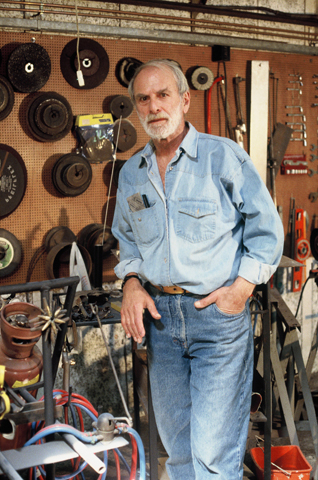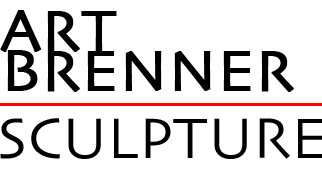

METAL SCULPTURE
The major part of my work is large-scale metal sculpture integrated with architectural and environmental spaces.
I work primarily in steel. For exterior work I often use weathering steel (corten) as it requires little maintenance. In some instances, stainless steel elements are incorporated.
The "mystery" of semi-transparent planes intrigues me as does movement -- real or virtual. I can create the effect of movement by superimposing two planes of perforated sheet or grills to produce infraction patterns -- moirés -- that move with the slightest movement of the viewer. Real movement is achieved in other cases by fixing elements by springs, allowing a slight vibration in the wind.
Elements are fabricated of sheet steel with flats on edge for borders and reinforcing ribs. The result is a very rigid panel. Further, apart from creating interesting defining shadows, these flats offer a real thickness to edge views (avoiding the effect of cutout cardboard no matter how thick the sheet).
It is my practice to prepare completely detailed working drawings for each project. This provides the occasion to refine forms, determine material sizes and quantities, define joints and other details, as well as to analyze structure and foundations in collaboration with an engineer. This procedure is followed whether sculptures are produced in my own workshop or fabricated (under my supervision) by competent metal construction firms.
I have had the opportunity to realize a large number of projects on widely varied sites. This broad experience provides a clear understanding of public art projects.
A large work of art intended for a public space is fundamentally different in its conception from a "gallery" piece. The artist's task in this case is to create a site-specific work of intrinsic aesthetic value. It might fulfill functions that are both aesthetic and utilitarian. The process is nonetheless one of solving art problems -- and solving them in the context of such fundamental issues as:
- Scale - perhaps the paramount issue in integrating a sculpture in its environment.
- Theme - which should have a relation to the site, to the interests or concerns of the user group and (perhaps) of the community at large.
- Structuring of the space - to elicit repeated interest and attention even as it is integrated into the environment.
The conception of a sculpture takes into consideration conflicting elements -- a dialectic of nature and culture, of future and past, etc. It should be rich in complexity -- and even contradictions -- that invites renewed interest both in the work and its environment.
The point of departure for most of my work is a figurative element -- often a historical or mythological figure related thematically to the site or its activities. The development is a mediation between solid, semi-transparent, and negative forms. I try to estabish a visual language (a system of relations) that can be read by the spectator -- that is to say, a system of signs and sybmols: a semiotic. This semiotic is the basic element in the "research" pertaining to the insertion of a sculpture in a specific context. The elements are, in general, geometric -- but taken together they do recall their figurative origin. The end is a sculpture penetrated by exterior space -- and by diverse interpretations.
The complexity of this dialectic, with all its ambiguities and even contradictions, enriches not only the sculpture itself but the environment as well.
Art Brenner
Other essays on sculpture by Art Brenner:
Concerning sculpture and architecture
The Urban Environment: the Role of Sculpture in Architecture